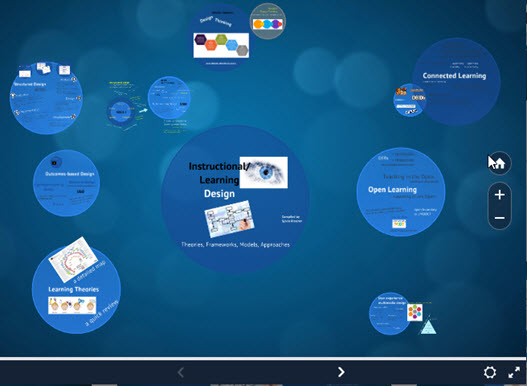Week 1: Overview
| Site: | SCoPE - BCcampus Learning + Teaching |
| Group: | Facilitating Learning Online - Design SEPT 2020 OER |
| Book: | Week 1: Overview |
| Printed by: | Guest user |
| Date: | Wednesday, 7 January 2026, 12:00 PM |
Description
Welcome to FLO Design! Each week's Overview book provides some insights into theory and practice.
Week 1 is about getting started - choosing and defining your Design Project - and in recalling or discovering some of the essential theories or concepts about how people learn.
Selecting / Defining Your Design Project
If you can't recall what the Design Project is, please review the description in the Course Handbook - Design Project.
Many of us begin with a task or intention to develop a course, but we don't have a clear idea of the answers to the seven questions: who, what, where, when, why, how, and how much?
To help you get started, we ask you to develop a mission (purpose) statement and be able to share it with others (initially through a paired interview activity). You'll find out more about the Interview activity from your FLO Design facilitators as you begin; you'll also find templates for developing your mission statement or structuring your interview in the Design Projects Documents folder.
How People Learn
This week's focus is both practical and theoretical - it is helpful to understand some of the learning theories and related models or frameworks that can guide your design choices. This book presents some key ideas and a list of references if you choose to go further.Some Definitions
educational design: any design activities that are intended to support learning; we use the term to include both instructional design and learning design. Note: these terms became widely used as more education was delivered with or supported by digital technologies and cloud-based tools.
instructional design: a systematic approach to using what we know about how people learn to guide the selection of instructional strategies or processes to help learners succeed in achieving learning outcomes. In current educational contexts, this also involves the judicious selection and use of technological tools and environments.
learning designer: a more recent term, it indicates an emphasis on the learner and a focus on the learner experience rather than instructional tasks.
learning design:
instructional design:
Overview
Welcome to FLO Design. Each week's Overview book presents concepts and information to help you understand more about underlying research and beliefs about learning and make you aware of (or remind you) of effective models, frameworks and approaches to designing courses.
Each week's book will also provide guidance to help you move through the tasks in the weekly Checklist to support your ongoing developing of your Design Project. If you are uncertain of what the Design Project is, please review the description in the Course Handbook (in the Hub).
Get Started - Design Project
Most learners find it easier to understand and remember complex concepts or information if they can apply new knowledge in some way. The Design Project is a chance for you to select an area of interest or a portion of an online course you need to (or want to) develop, and then use it as the focus of your applied learning.
We've asked you to limit your chosen project to take place over roughly 2-3 weeks of an online course. By narrowing the scope of your project, we believe you'll have time to step back, consider a wider range of options to inform your pedagogical choices, and integrate any new ideas or feedback that suits your needs.
As you develop your plan for your online unit of learning, we'll also
ask you to select and describe/share a prototype learning activity.
Week 1 Design Project steps:
1. Select a theme or topic for your unit of learning.
2. Think carefully about your purpose or goal(s) - write a Mission statement for your unit of learning.
3. Participate in the Interview activity (further details are shared in the Interview Activity document embedded in the Week 1 section).
Did the process make you rethink your draft Mission statement?
4. Interview reports will be posted to the Studio forum by the end of the week. Take time to review the topics and Mission statements. If you're interested in working with someone, post your request to the Studio forum before Week 2.
5. You are asked to post your selected topic and mission statement to the Week 1 Studio forum. Take time to review other postings. You are welcome to work with others or on your own but the choices should be made (and shared) before the start of Week 2.
How People Learn
Educators have been trying to understand the way people learn for a long time. Although we rely on our own observations and experiences in teaching, we can benefit from considering some of the current research and recommendations published by respected publishers, institutions or researchers/instructors.
Behaviourism includes theories that are based on changes in behaviour that can be directly observed and measured. Cognitivism includes theories that focus on the way the human brain take in information and stores it for recall and application. Constructivism includes
a range of theories that begin from a subjective perception of reality
and may include a belief that learning occurs through social
interactions. A final theory (still argued by many) is Connectivism.
This theory was developed to address the way learning has changed due
to the exponential increase in information due to advances in digital
technologies and connectivity. A central belief is that learning occurs
primarily (most effectively?) through networked learning.
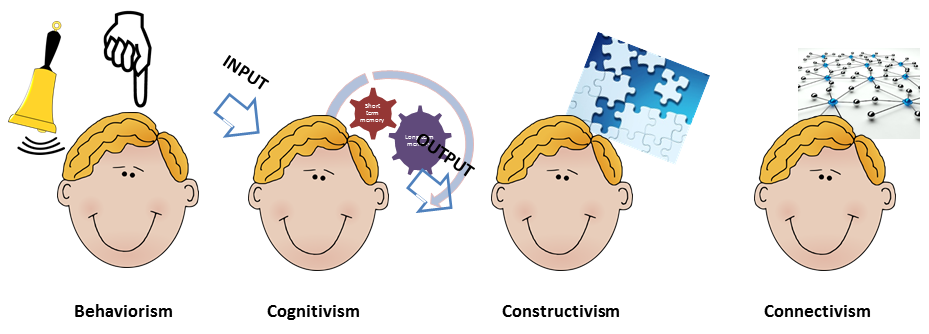
| Behaviourism | Cognitivism | Constructivism | Connectivism | |
|---|---|---|---|---|
| How does learning occur? | stimulus -> response; observable behaviour main focus, chaining events | input -> process -> output (learning) structured, computational | meaning created by each learner (personal);focus on social learning | Distributed within a network, social, technologically enhanced, recognizing and interpreting patterns |
| What factors influence learning? | nature of stimulus (reward; punish), timing of events | existing schema, previous experiences | Engagement, participation, social, cultural | Diversity of network |
| What is the role of the memory | Repeated experiences are remembered - timing & type of reward / punishment are most influential | Encoding to long term memory, retrieval | Prior knowledge remixed to current context | Adaptive patterns, representative of current state, existing in networks |
| How does transfer occur? | Stimulus, response | Duplicating knowledge constructs of "knower" | Socialization | Connecting to (adding nodes) |
|
What types of learning are best explained by this theory? | Task-based learning | Reasoning, clear objectives, problem solving | Social, vague ("ill defined") problem solving | Complex learning, rapid changing core, diverse knowledge sources |
|
Names of some theorists | I. Pavlov, B.F. Skinner, J. Watson | D. Ausubel, J. Bruner, R. Gagne | J. Dewey, L. Vygotsky, E. von Glaserfeld | S. Downes & G. Siemens |
More perspectives on learning
Many instructors observe that learners are more involved and seem to retain what they learn more effectively if they are ACTIVE (or engaged in some way. Active learning can be physical or mental; the important factor seems to be that something is required of the learner.
Experiential learning
One of the most well-known theories of learning is David Kolb's Cycle of Experiential Learning (associated with concepts of adult learning i.e., andragogy as opposed to pedagogy). If you've been involved in Instructional Skills Workshops in the past, you'll definitely have heard of this one.
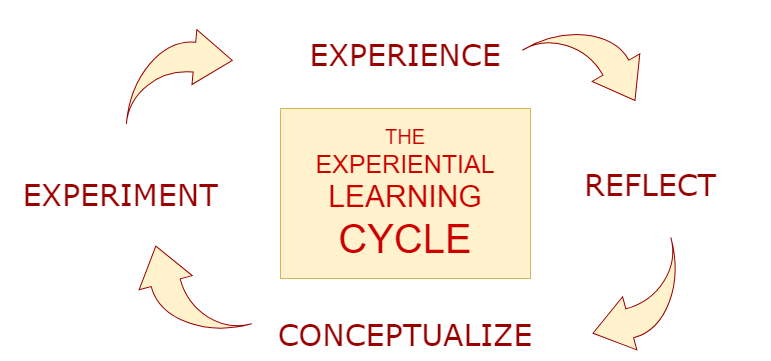
Brain-based perspectives
As neurological research has evolved, more educators have been exploring brain-based ideas of how people learn. Although there are critics of this approach, it is useful to review what we know about how the brain learns and some of the suggestions of how to support learning using that knowledge. The following is an open-licensed video from ETEC510 Brain based learning (a course in the Masters of Educational Technology program at University of BC.Indigenous perspectives
There has been a growing awareness of the value of exploring indigenous ways of knowing and learning. Key aspects are relationality, the interconnection between sacred and secular and 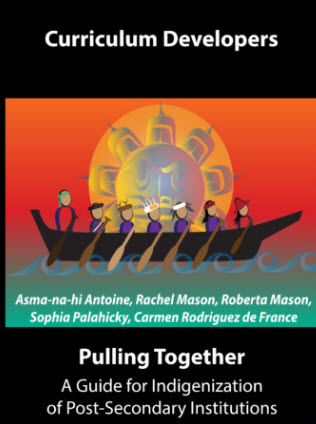 holism, the need to see the whole picture because everything is related and cannot be separated. Often, indigenous ideas of knowledge are expressed as four connected dimensions (also referred to as the medicine wheel: emotional, spiritual, cognitive and physical. 1
holism, the need to see the whole picture because everything is related and cannot be separated. Often, indigenous ideas of knowledge are expressed as four connected dimensions (also referred to as the medicine wheel: emotional, spiritual, cognitive and physical. 11 Pulling Together: A Guide for Curriculum Developers., Asma-na-hi Antoine, Rachel Mason, Roberta Mason, Sophia Palahicky, and Carmen Rodriguez de France, retrieved from https://opentextbc.ca/indigenizationcurriculumdevelopers/
How People Learn Online
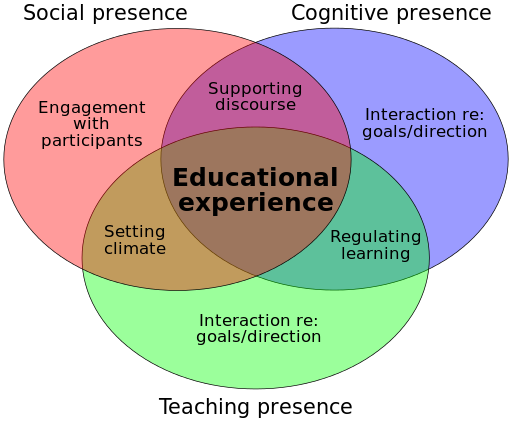
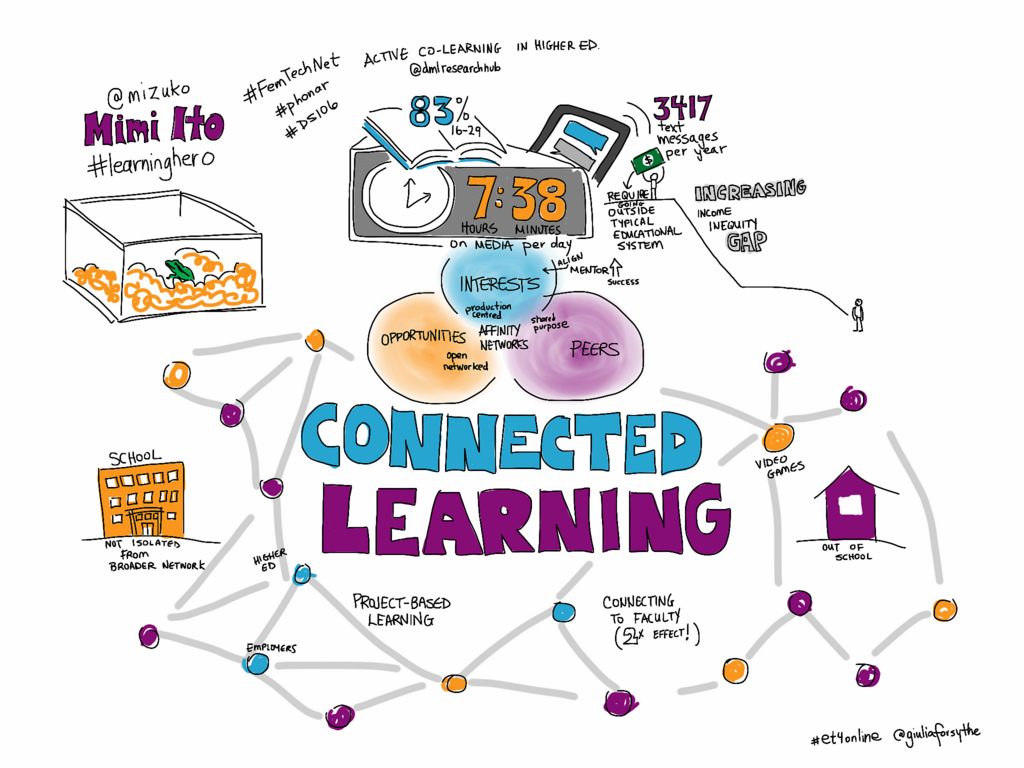
Learn more
If you'd like to learn more about how people learn, and the impact of connectivity and technology on learning, the following is a selected list of books, videos and podcasts you may find useful.
Books
Ambrose, S. A., Bridges, M. W., DiPietro, M., Lovett, M. C., & Norman, M. K. (2010). The Jossey-Bass higher and adult education series.How learning works: Seven research-based principles for smart teaching. Jossey-Bass. Bates,
A. Tony (2019) Teaching in a Digital Age, Second Edition, retrieved from https://www.tonybates.ca/teaching-in-a-digital-age/
Bransford, John D., et al, (editors), Committee on Developments in the Science of Learning, National Academies of Sciences (2000). How People Learn: Brain, Mind, Experience and School, retrieved from https://www.nap.edu/catalog/9853/how-people-learn-brain-mind-experience-and-school-expanded-edition
Brown, P. C., Roediger, H. L. III, & McDaniel, M. A. (2014). Make it stick: The science of successful learning. Belknap Press of Harvard University Press.
Dirksen, J. (2016). Design for how people learn. San Francisco: New Riders.
Harasim, L. M. (2017). Learning theory and online technologies. New York: Routledge.
- -see table of contents at Google Books
Nussbaum-Beach, Sheryl. (2012). The connected educator: learning and leading in a digital age. Bloomington, Indiana: Solution Tree Press.
Vaughan, Norman D., Martha Cleveland-Innes, D. Randy Garrison (2013). Teaching in Blended Learning Environments: Creating and Sustaining Communities of Inquiry, Athabasca: Athabasca University Press
- Download cc-licensed pdf or view online - https://www.aupress.ca/books/120229-teaching-in-blended-learning-environments/
Articles, journals, web references
Fredholm, Lotta (2001) Ivan Petrovich Pavlov (1849-1936). Nobelprize.org. Retrieved from https://www.nobelprize.org/educational/medicine/pavlov/readmore.html
Greengrass, M. (2004) 100 Years of B.F. Skinner, American Psychological Association. Retrieved from http://www.apa.org/monitor/mar04/skinner.aspx
Millwood, Richard. (2013) Learning Theory, v6, Holistic Approach to
Technology Enhanced Learning (EU-funded project), retrieved from https://blog.richardmillwood.net/2013/05/10/learning-theory/
Robert Gagne's Nine Learning Events: Instructional Design for Dummies. (2017, March 8). ETEC 510, . Retrieved 15:13, September 27, 2020 from http://etec.ctlt.ubc.ca/510wiki/index.php?title=Robert_Gagne%27s_Nine_Learning_Events:_Instructional_Design_for_Dummies&oldid=63738.
Scientific Reasoning Research Institute. von Glasersfeld, Ernst. Radical Constructivism. Retrieved from https://www.srri.umass.edu/vonglasersfeld/
Siemens,
George (2005) Connectivism: A Learning Theory for the Digital Age,
International Journal of Instructional Technology and Distance Learning.
Retrieved from http://www.itdl.org/Journal/Jan_05/article01.htm
Smith, M.K. (2002) ‘Jerome S. Bruner and the process of education’, The encyclopedia of pedagogy and informal education. [https://infed.org/mobi/jerome-bruner-and-the-process-of-education/ Retrieved: September 22, 2020
Smith, M. K. (2003). ‘Learning theory’, the encyclopedia of informal education. Retrieved from http://infed.org/mobi/learning-theory-models-product-and-process/
University of Leicester, Learning theories, David Kolb, retrieved from https://www2.le.ac.uk/departments/doctoralcollege/training/eresources/teaching/theories/kolb
University College of Dublin Teaching and Learning Open Educational Resources, Education Theory, Constructivism and Social Constructivism. - see Main Theorists: John Dewey, Lev Vygotsky, retrieved from http://www.ucdoer.ie/index.php/Education_Theory/Constructivism_and_Social_Constructivism
Weibell, C. J. (2011). Behaviorism (John B. Watson) Principles of learning: 7 principles to guide personalized, student-centered learning in the technology-enhanced, blended learning environment. Retrieved Nov. 4, 2016 from [https://principlesoflearning.wordpress.com].
Wikipedia article - David Ausubel - Retrieved from https://en.wikipedia.org/wiki/David_Ausubel
Wikipedia article - John Dewey - Retrieved from https://en.wikipedia.org/wiki/John_Dewey
Interactive resources
If you want to learn more about how learning theories may affect your design choices, explore these interactive resources.
1. Richard Millwood's amazing open licensed concept map of technology enhanced learning, prepared for a European Union project: HoTEL (Holistic Approach to Technology Enhanced Learning). You can download the pdf or explore the interactive cmap version with links to Wikipedia articles.
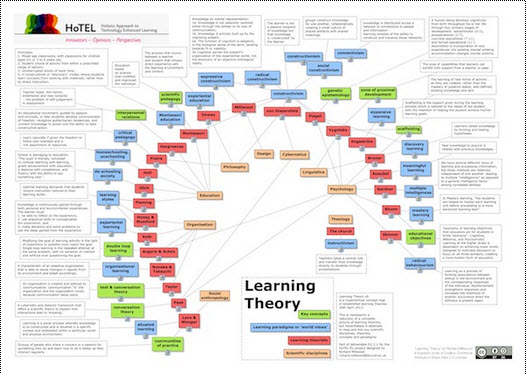
2. Sylvia Riessner's compilation of learning theories and related resources "Design for Learning" - an interactive Prezi
